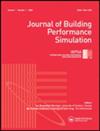基于人工神经网络和多目标优化的中国寒区乡村房屋性能和经济性改进
IF 2.3
4区 工程技术
Q2 CONSTRUCTION & BUILDING TECHNOLOGY
引用次数: 0
摘要
在建筑设计阶段考虑建筑性能优化(BPO)的研究越来越多,但现有的许多研究在增加目标维度时没有考虑多目标优化算法的适用性。本文首先比较了NSGA-II、IDBEA、msop - ii和NSGA-III算法。然后,将最适合多目标优化的算法与人工自然网络(ANN)和TOPSIS-AHP相结合,完成了中国寒区村舍建筑能耗(EC)、有效日照度(UDI)、舒适时间比(CTR)和节能围护结构成本(ESEC)四个维度的优化。结果表明,与其他三种算法相比,NSGA-III算法在求解多目标问题时具有较好的收敛速度、收敛性、多样性和均匀性。最后,采用TOPSIS-AHP方法选择了4种优化策略。本文章由计算机程序翻译,如有差异,请以英文原文为准。
Based on ANN and many-objective optimization to improve the performance and economy of village houses in Chinese cold regions
The number of studies considering building performance optimization (BPO) in the building design phase is steadily growing, but many of the existing studies do not consider the applicability of many-objective optimization algorithms when increasing the objective dimensions. This article first compares the NSGA-II, IDBEA, MSOPS-II, and NSGA-III algorithms. Then, the algorithm most suitable for many-objective optimization is combined with Artificial natural network(ANN) and TOPSIS-AHP to complete the optimization of four dimensions of building energy consumption (EC), useful daylight illuminance (UDI), comfort time ratio (CTR) and energy-saving envelope cost (ESEC) for village houses in cold regions of China. The results show that the NSGA-III algorithm performs well in terms of convergence speed, convergence, diversity, and uniformity when solving many-objective problems compared to the other three algorithms. Finally, four optimization strategies were selected using the TOPSIS-AHP method.
求助全文
通过发布文献求助,成功后即可免费获取论文全文。
去求助
来源期刊

Journal of Building Performance Simulation
CONSTRUCTION & BUILDING TECHNOLOGY-
CiteScore
5.50
自引率
12.00%
发文量
55
审稿时长
12 months
期刊介绍:
The Journal of Building Performance Simulation (JBPS) aims to make a substantial and lasting contribution to the international building community by supporting our authors and the high-quality, original research they submit. The journal also offers a forum for original review papers and researched case studies
We welcome building performance simulation contributions that explore the following topics related to buildings and communities:
-Theoretical aspects related to modelling and simulating the physical processes (thermal, air flow, moisture, lighting, acoustics).
-Theoretical aspects related to modelling and simulating conventional and innovative energy conversion, storage, distribution, and control systems.
-Theoretical aspects related to occupants, weather data, and other boundary conditions.
-Methods and algorithms for optimizing the performance of buildings and communities and the systems which service them, including interaction with the electrical grid.
-Uncertainty, sensitivity analysis, and calibration.
-Methods and algorithms for validating models and for verifying solution methods and tools.
-Development and validation of controls-oriented models that are appropriate for model predictive control and/or automated fault detection and diagnostics.
-Techniques for educating and training tool users.
-Software development techniques and interoperability issues with direct applicability to building performance simulation.
-Case studies involving the application of building performance simulation for any stage of the design, construction, commissioning, operation, or management of buildings and the systems which service them are welcomed if they include validation or aspects that make a novel contribution to the knowledge base.
 求助内容:
求助内容: 应助结果提醒方式:
应助结果提醒方式:


